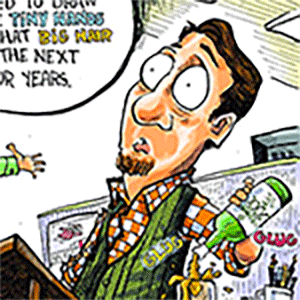On Chicago's Northwest Side, dispute and confusion over how to address homeless encampment
Published in News & Features
CHICAGO — A gray Honda CRV pulled out of traffic Wednesday afternoon on Pulaski Road and stopped near the homeless encampment that stretches along the fence between Gompers Park and the Salvation Army Mayfair Community Church.
“Stay the (expletive) out of Gompers Park!” the driver yelled before he rolled up the window and rejoined southbound traffic.
Agata Janick jumped, then sighed.
“That has never happened to me, ever,” said Janick, 43. “Just when I said people usually leave us alone.”
Janick estimated she has 15 neighbors who live part- or full-time in the roughly 20 tents scattered throughout the Northwest Side park. She would love to get out of the park, and would not be picky about housing options if they were offered to her, though she’d prefer to stay on the Northwest Side if she can.
“South Side, West Side, I’ll take anywhere,” she said.
The encampment where Janick has lived for two years is the latest flash point in a sometimes-heated debate over how Chicago should approach its rising homeless population.
Earlier this week, North Mayfair and North Park residents clashed over how to address the Gompers Park encampment and the people living there. Many who packed a community meeting Monday were concerned about cleanliness and drug use and erratic behavior by encampment residents as well as their living conditions, particularly with another Chicago winter approaching.
Other residents also support offering park dwellers permanent housing but argue that they should have more agency in that process. Their primary worry is for the encampment residents’ safety and security while they remain in the park, echoing advocates’ point that people experiencing homelessness are at high risk of being victims of violent crime.
That risk was on full display last month when four people were shot and killed as they slept on a Blue Line train in the early hours of Labor Day.
The encampment will stay put for now, city leaders said Monday: the city has reached its capacity for accelerated moving events, which condense the process of placing a person into permanent housing — from documentation to choosing a unit to getting furniture to moving in — into the span of a few days.
“I think that people are very frustrated because they don’t know who’s in charge,” Ald. Samantha Nugent, 39th, told the Tribune. “If there (are) standard operating procedures or policy governing how, how other city agencies are supposed to respond and interact in situations like this. I have yet to see it.”
It is the second time in a matter of months that Nugent has had to deal with a large homeless encampment in her ward. Earlier this summer, the city cleared a homeless encampment next to Northside College Preparatory High School in the North Park neighborhood.
She has been vocal about her hope to get tents out of Gompers Park and their occupants rehoused and said she wanted more guidance about how to best respond to the encampment as officials craft a longer-term plan.
A spokesperson for Chief Homelessness Officer Sendy Soto said the office was unable to provide comment.
The city has historically prioritized finding housing for its homeless, many of whom stay in airports, on public transit or in tent cities across its parks and under bridges. But the effort to reduce homelessness in the city faces major challenges, including low affordable housing stock and depleted federal and state funding.
Mayor Brandon Johnson championed the Bring Chicago Home referendum, which sought to raise millions for homelessness services by raising the city’s real estate transfer tax for property sales above $1 million as a funding solution. The referendum failed at the ballot box in March. Johnson pledged to keep pushing, saying, “Whatever we didn’t get the first time, we’ll get even more the next time.”
Shortly after, the City Council approved a $1.25 billion bond, $625 million of which is set to be dedicated to housing, according to the city’s report on homelessness. And the recently appointed Soto’s first major task in office is to create a five-year plan to address homelessness in the city.
City officials are also in the early phases of overhauling its shelter systems for migrants and non-migrant homeless in what they’ve dubbed a One System Initiative. Chicago is receiving fewer asylum-seekers from the southern border after welcoming almost 50,000 migrants in about two years, and social service leaders have recommended the city retain the shelter bed supply it created for new arrivals and merge them with the roughly 3,000 existing homeless shelter beds.
Restore
Nicole Foster, one of the founding members of the Restore Gompers Park Coalition, opened Monday’s meeting between residents and city officials at the Salvation Army Church with a plea for the city to remove tents from the park and rehouse the people living in them.
“(Cleanup crews) uncovered used drug needles, knives in trees and trucks, scores of alcohol containers, bags of human feces and used sanitary pads,” she said. “The garbage is often overflowing. There are open fires.”
Foster’s group petitioned Johnson, Nugent, Park District and Department of Family Support Services leaders in September to clear the tents and offer residents housing. Their petition listed environmental damage, cleanliness and “rampant” illegal activity among their concerns about the encampment.
Speaking Monday night, Foster said the conditions in the park were also unacceptable for the people who live there.
“If my children fell on hard times, I wouldn’t want this to happen to them,” she said. “We’re asking that Gompers Park be restored to the safe and nature of space it once was so everyone can enjoy it again.”
Most of the room erupted into applause. But one man was escorted out shouting and others held paper plates that read “NO, I DISAGREE, I OPPOSE.”
Adam Gianforte had been handing out the plates to people outside the meeting. Gianforte, 31 and a member of the progressive group 39th Ward Neighbors United, said he felt the people who backed the Restore Gompers Park coalition were a “vocal minority.”
“Ordinary neighbors don’t want to see anyone homeless, but they don’t want anyone forced out, if it’s not into a better living situation,” he said. “They’re our poorest neighbors, and should be responded to as such, not as criminals.”
He said he supported an effort to rehouse people “to the extent that people are free to choose or deny the housing proper to them.”
Sarah-Jayne Ashenhurst, 39, also of 39th Ward Neighbors United, felt the discussion around rehousing park dwellers was “shorthand for eviction” and said the coalition’s goal was “getting people out of the park and keeping them out of the park forever.”
Ashenhurst was focused on the safety of the people in the encampment and said she feared they would be harassed.
Restore Gompers Park Coalition members countered that their push to house encampment residents had brought more services to the tent site and said they were sympathetic to the people living there.
“No one would want to see their family member living like this and requesting (permanent housing) is to get them help,” said Gail Beitz, 70. “I think of these people during winter time — they should not be in tents in the freezing temperatures.”
Ashenhurst added that other homeless people could arrive and settle in Gompers Park after the current residents are housed. She called on Nugent to bring more affordable housing options to the ward as a long-term solution for homelessness.
The encampment will remain in Gompers Park in the short term “for better or for worse,” she said.
“But tomorrow, Ald. Nugent could say, ‘OK, I am going to lay the groundwork for a shelter in this community, for affordable housing in this community,’” Ashenhurst said. “That’s what I want to see.”
Tents will remain for now
For now, the tents are going to stay in Gompers Park.
Department of Family and Support Services First Deputy Commissioner Maura McCauley said the department had a set list of encampments and other locations that would see the kind of rehousing Nugent and the Restore Gompers Park coalition support. The earliest residents would be housed and tents cleared would be next year, McCauley said.
In the meantime, DFSS, the Chicago Department of Public Health, the Chicago Park District and police will continue to regulate and offer services at the encampment. McCauley promised those at the meeting that the department would continue offering temporary shelter and other assistance to those at the encampment.
Nugent was disappointed.
“The people that are experiencing homelessness deserve to be in some type of housing, and I think that’s the right path,” she told the Tribune.
She said she felt people weren’t getting “straight answers” on questions of how park rules should be enforced and which agency was responsible.
“The Park District doesn’t quite know when they are to enforce, when they are not to enforce,” she said. “I’m looking for the chief homelessness officer to give me suggestions on how to help a community.”
Albany Park District police Cmdr. Jesse Alvarez said Monday that calls for service around the park were up by about 20%. But most of those were requests for emergency medical services, he said. The number of disturbances at the park has doubled since 2023, he said.
One resident asked officials Monday what they could do to enforce park rules such as the 11 p.m. curfew or a no-tent policy on residents of the encampment. The question prompted Soto to distinguish criminal activity from life activities such as sleeping or cooking that people would otherwise do in a home, but which encampment residents must conduct outside.
“If you’re in danger or somebody else is in danger, you should always report to the police,” Soto said. “Homelessness is not a criminal activity. The city will not criminalize people who are homeless.”
Janick, the two-year resident of the encampment, said Wednesday there have been a few extra cleanups and visits from the city in recent weeks.
“There was a guy who came out yesterday and was talking about how there is no funding,” she said.
After staying in the park for two years, she knows a lot of the people around the area, she said, and would like to stay close to them if she can.
Then the man rolled up in his car and shouted out the window. Janick was rattled but she shook it off after a couple of minutes.
“(He) could walk in my shoes one day,” she said. “I don’t really care.”
©2024 Chicago Tribune. Visit chicagotribune.com. Distributed by Tribune Content Agency, LLC.







Comments